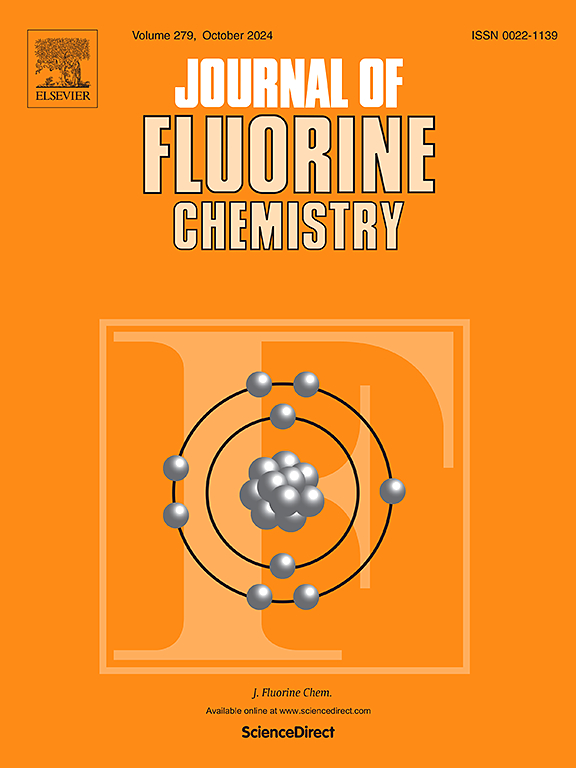1173 K时Si(IV)离子在LiF-SiO2和KF-SiO2熔体中的电化学还原行为
IF 1.9
4区 化学
Q3 CHEMISTRY, INORGANIC & NUCLEAR
引用次数: 0
摘要
金属氧化物金属电沉积不仅有利于地球上的金属冶炼过程,而且有利于从月球和火星上的矿物中回收金属。在电化学过程中,金属氧化物和金属氟化物的二元熔体可以作为一种有前途的反应介质,用于构建一种实用的电解系统,可以在较低的温度下直接从金属氧化物中回收金属。在1173 K(含10 mol% SiO2)条件下,研究了Si(IV)离子在LiF-SiO2和KF-SiO2熔体中的电化学还原行为,以控制高SiO2组成比高温熔体中结晶Si的电沉积过程。利用高温拉曼光谱和密度泛函理论计算研究了SiO2的溶解行为,发现在KF-SiO2体系中形成了si3f7 - 2k等Si(IV)配合离子,而Si(IV)离子不易与LiF-SiO2熔体的组成离子结合。结果表明,两种熔体均可通过恒电位电解得到多晶Si,且在LiF-SiO2体系中Si(IV)离子的还原速率更快。拉曼光谱和x射线衍射分析表明,沉积物为多晶硅和Li-Si、K-Si等合金。本文报道的金属氟化物与SiO2二元熔体中氟离子与Si(IV)离子相互作用的数据将有助于实现从SiO2中一步回收Si的原位资源利用工艺。本文章由计算机程序翻译,如有差异,请以英文原文为准。

Electrochemical reduction behavior of Si(IV) ions in LiF-SiO2 and KF-SiO2 melts at 1173 K
Metal electrodeposition from metal oxides is beneficial not only in the terrestrial metal smelting process but also in the process of recovering metals from minerals on the Moon and Mars. In the electrochemical process, a binary melt of metal oxide and metal fluoride can be a promising reaction media for constructing a practical electrolytic system that allows metal recovery directly from metal oxide at lower temperatures. In this study, the electrochemical reduction behavior of Si(IV) ions in LiF-SiO2 and KF-SiO2 melts at 1173 K, which included 10 mol% SiO2, was studied toward controlling the electrodeposition process of crystalline Si in high-temperature melts with higher SiO2 composition ratios. The dissolution behavior of SiO2 was investigated by high-temperature Raman spectroscopy and density functional theory calculation, revealing that Si(IV) complex ions such as Si3F7–2 K are formed in the KF-SiO2 system, whereas Si(IV) ion was not easily bonded to constituent ions of the LiF-SiO2 melt. It was demonstrated that polycrystalline Si could be obtained by potentiostatic electrolysis in both melts, and the reduction rate of Si(IV) ions was faster in the LiF-SiO2 system. The Raman spectroscopy and XRD analysis revealed that the electrodeposits were the polycrystalline Si and the alloys such as Li-Si and K-Si. The reported data on the interaction between fluoride ions and Si(IV) ions in the binary melt of metal fluoride and SiO2 will contribute to realizing an in-situ resource utilization process that enables one-step Si recovery from SiO2.
求助全文
通过发布文献求助,成功后即可免费获取论文全文。
去求助
来源期刊

Journal of Fluorine Chemistry
化学-无机化学与核化学
CiteScore
3.80
自引率
10.50%
发文量
99
审稿时长
33 days
期刊介绍:
The Journal of Fluorine Chemistry contains reviews, original papers and short communications. The journal covers all aspects of pure and applied research on the chemistry as well as on the applications of fluorine, and of compounds or materials where fluorine exercises significant effects. This can include all chemistry research areas (inorganic, organic, organometallic, macromolecular and physical chemistry) but also includes papers on biological/biochemical related aspects of Fluorine chemistry as well as medicinal, agrochemical and pharmacological research. The Journal of Fluorine Chemistry also publishes environmental and industrial papers dealing with aspects of Fluorine chemistry on energy and material sciences. Preparative and physico-chemical investigations as well as theoretical, structural and mechanistic aspects are covered. The Journal, however, does not accept work of purely routine nature.
For reviews and special issues on particular topics of fluorine chemistry or from selected symposia, please contact the Regional Editors for further details.
 求助内容:
求助内容: 应助结果提醒方式:
应助结果提醒方式:


